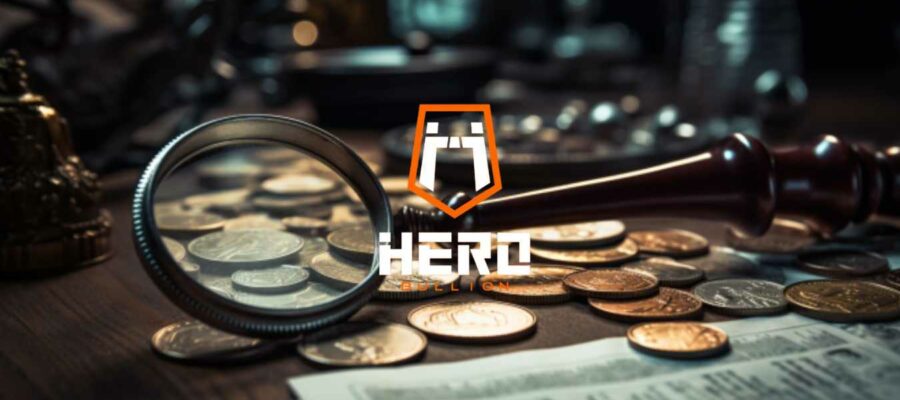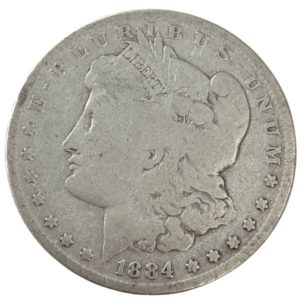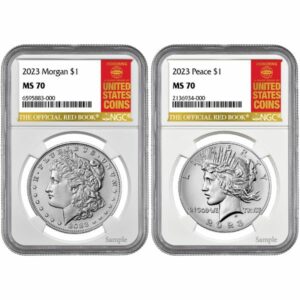How to Grade Coins at Home

A coin’s grade, or condition, is an extremely important part of its appeal. While precious metal content is an important aspect of a gold or silver coin’s base value, the total cost of a bullion coin depends heavily on its condition. Coins in poor condition are likely to sell closer to their melt value in silver or gold, but pieces kept in MS65+ condition could potentially go for thousands of dollars over the value of their underlying precious metals.
Professional coin grading services might be an excellent investment, especially if your coins are exceptionally rare or valuable. But not every investor is interested in paying to have their coins graded by experts. If you’re wondering how to grade coins at home, you’ve come to the right place. Grading coins at home can help you estimate the value of your investment while also providing valuable information about the history and context of your collectable coins.
How Coin Grading Works
Before we can explain how to grade coins at home, investors should understand how coin grading works. Coins are generally assigned a “grade” to represent their condition relative to other specimens. Several factors determine how to grade coins at home, and we’ll cover these strategies later in our guide. For now, note that coins are generally graded on a system known as the Sheldon Scale, and that the condition of your coin is an important factor in determining its total value to collectors.
Understanding the Sheldon Scale
Most collectable coins are evaluated using the Sheldon Scale. The Sheldon Scale is a standardized system that allows coin collectors to determine how well their circulated or uncirculated coins have been maintained over the years.
Coins are almost always graded on a scale from 1-70, with one being exceptionally poor condition and 70 being completely perfect. MS70 coins are exceptionally rare. Generally, they come directly from the manufacturing mint and are never taken out of their protective cases. Even under 8x magnification, these coins will have no visible flaws. If you want to know how to grade coins at home, you should understand what true perfection looks like in a coin. Generally, perfection looks like an MS70 silver or gold coin.

On the other end of the spectrum, we find coins graded 1. Coins with this grade are often damaged and are barely identifiable at all. To get this grade, coins must still possess a clear date and mintmark.
Why Does Coin Grade Matter?
Investors often want to know how to grade coins at home. But collectors also frequently ask us: why does the grade of a coin even matter? For most people, the primary function of coin grading is to determine a coin’s value. As we explained at the beginning of this guide, coins with a near-perfect grade are often extremely valuable, especially when compared to pieces kept in poor condition.
Some investors actually prefer coins in extremely poor condition. Also known as “low ball” coins, these pieces feature no damage but almost complete degradation. Low ball coins are worn down until the design is almost entirely flat, but they maintain their key identifying features. Because coins of this age and level of circulation are almost always damaged beyond recognition, finding a perfectly worn-down low ball coin is exceedingly rare. These coins can also be worth quite a bit of money to the right collector.
Essential Tools for Home Coin Grading
When collectors ask us how to grade coins at home, they sometimes have a poor understanding of the tools necessary to properly evaluate a coin’s condition. For the most part, you can figure out how to grade coins at home with three main tools: proper lighting, gloves for coin handling, and magnifiers.
Proper Lighting
The first tool a professional coin grader should invest in is a lighting system. Professional Coin Grading Services recommends using 75-100 watt incandescent bulbs. The goal is to light up your grading area enough to be able to note all of the details necessary on the coins you choose to grade.
Gloves for Coin Handling
Before you should ask us how to grade coins at home, we recommend taking some time to research proper coin handling. The chemicals produced by your hands and fingers can degrade the condition of a coin, so it’s essential that you develop a method of handling your coins safely and securely. Investing in some cotton gloves can help you keep your coins pristine during the grading process; the last thing any coin collector wants is to lose value on their investment by handling their coins improperly.

Magnifying Tools
You’ll need a magnifying glass if you want to know how to grade coins at home. Most graders use magnifiers with 5-10x power. Whether you go with a higher or lower grade magnifier, you’ll need something capable of spotting even the smallest details on a coin. The highest-graded coins will include few – or no – evidence of degradation, even at 8x magnification.
Anatomy of a Coin
To really get how to grade coins at home, we recommend studying the anatomy of a coin. Learning the different parts of your coin can make you a better novice coin grader. We’ll cover all the main parts of a standard coin below: the rim, edge, field, and mint mark.
The Rim
The rim is often confused with the edge of a coin. While the edge refers to the actual sides of the coin, which can be ridged or flat, the rim is the slightly raised part of a coin that leads into the edge. Damage can happen to the rim of a coin, especially if it’s dropped onto a hard surface. Inspecting the rim is an important part of how to grade coins at home.
The Edge
Much like the rim of a coin, a coin’s edge can become damaged through excessive circulation and handling. This decreases the value of a coin by lowering its grade. Investors wondering how to grade coins at home should magnify this area of the coin to look for signs of wear, damage, or irregularities. Research your coin to learn what features it should have on its edge; some coins have reeding or lettering, while others are completely plain.
The Field
The field refers to the background area behind a design. There should be a field on both the obverse and reverse of your coin. Some coin graders learning how to grade coins at home mistakenly believe that coins can only be damaged on their designs. In reality, some coins receive a lower grade than others because they include marks or scratches on the delicate field behind its designs. When you’re learning how to grade coins at home, careful examination of the field is a key part of the process.
Mint Mark
Contrary to popular belief, the mint mark of a coin is an important aspect of its condition – as well as its value. Over time, the mint mark and date of a coin can wear down, making it harder to identify. Using your magnifying glass, zoom in and take a close look at your numismatic coin’s mint mark and date. Both elements should be clearly visible. Collectors looking for how to grade coins at home should take care to avoid forgetting the mint mark, an essential element of legitimate and highly graded coins.

Inspect for Damage and Wear
Damage and wear are two separate things. After decades of changing pockets and being handled by collectors, coins naturally accrue wear. Wear makes it slightly harder to make out the details on a coin. Often, coins that have exceptional wear will seem more ‘flat’ than coins in great condition. Damage, on the other hand, doesn’t occur naturally. Marks or scratches on the surface and field of a coin count as damage and can significantly decrease the grade assigned to a coin.
How Wear Affects Coin Grade
Once you understand the basics of how to grade coins at home, you should develop a strategy for determining how wear affects coin grade. This takes quite a bit of practice. Even experienced numismatic coin investors sometimes struggle to pinpoint the precise grade of their valuable coins. Generally, you should understand that the more wear a coin has, the lower its condition will be on the Sheldon Scale.
Analyze Surface Quality
Especially when it comes to ancient or exceptionally old coins, surface quality is an important aspect of a coin’s grade. Numismatic coin collectors interested in learning how to grade coins at home should pay careful attention to the surface quality of their collectables. Several factors influence a coin’s surface quality, including regular wear, burial and recovery, and damage. Some coin grading experts actually rate a coin’s surface quality separate from its strike quality and traditional grade.
Determine Luster and Toning
Coins that maintain their original mint luster are often graded higher than coins that maintain little of this luster. When coins are struck at a mint, its internal metals move from the middle to the outside of each piece. The result is a series of very small grooves, creating a unique reflecting quality that characterizes near-perfect coins. This is known as luster. Over time, it’s easy for coins to lose their original mint luster, and trying to replicate this luster can destroy the value of a coin.
How Luster and Toning Affects Coin Grade
Toning, on the other hand, can either improve or decrease the value of a coin. Toning happens when coins are exposed to oxygen. Various types of toning can exist on coins. Morgan Silver Dollars, for example, often include a ‘crescent’ toning. This crescent toning happens when Morgan Dollars are kept in cloth bags on top of one another for a long period of time. Generally, toning decreases the grade of a coin. In some cases, investors might pay extra for coins with toning that brings out the key feature of their favorite investments.
Comparing Coins to Professionally Graded Examples
Once you know how to grade coins at all, you need to find a way to verify the accuracy of your examinations. One solid way to do this is to find professionally graded examples online. This isn’t always possible, and it can be difficult to compare coins without holding both of them physically, as online images don’t allow for the kinds of close-ups necessary to do the grading process right.
But finding examples of your coin in its identified grade online can be a fantastic way to decide whether or not your grading process has been accurate. Look to verify that your coin has the same amount of wear and damage as other coins in its grade. Pay careful attention to luster and toning levels.
After Grading Your Coins
After you learn how to grade coins at home, you still have a bit of work to do. We’ll cover proper coin storage and how to determine the value of a coin below.
Proper Coin Storage
Especially if your coin is rare and in excellent condition, properly storing your investment is paramount. Coins that are graded highly might not stay that way forever. Exposure to oxygen can slowly destroy the fine condition that made your collectable valuable in the first place. Keep expensive precious metal coins in a cool, dry place, and avoid stacking them on top of one another. Doing so can keep your coins in excellent condition for years to come. Investors who take the time to learn how to grade coins at home should be careful to properly store their investments.

For exceptionally expensive coins, we recommend investing in another form of storage. Some mints might allow you to keep your coins secure in their professional vaults; this added layer of protection is virtually guaranteed to keep your coins completely secure and safe for years to come. Regardless of what you know about how to grade coins at home, storing your investments is essential.
How Does Coin Grade Affect Value?
Coin grade is one of the most important aspects of a coin’s value. If you’ve learned how to grade coins at all, your next step is to learn to determine the value of your collectable. Viewing auction results, coin grading guides, and other investor resources can help you get an accurate valuation for your collectable coin.
Final Thoughts: How to Grade Coins at Home
Investors often want to know how to grade coins at home. We hope we’ve given you all the information you need to accurately and consistently evaluate the condition of your coins from the comfort of your own home.
You might also like:
About The Author
Michael Roets
Michael Roets is a writer and journalist for Hero Bullion. His work explores precious metals news, guides, and commentary.
